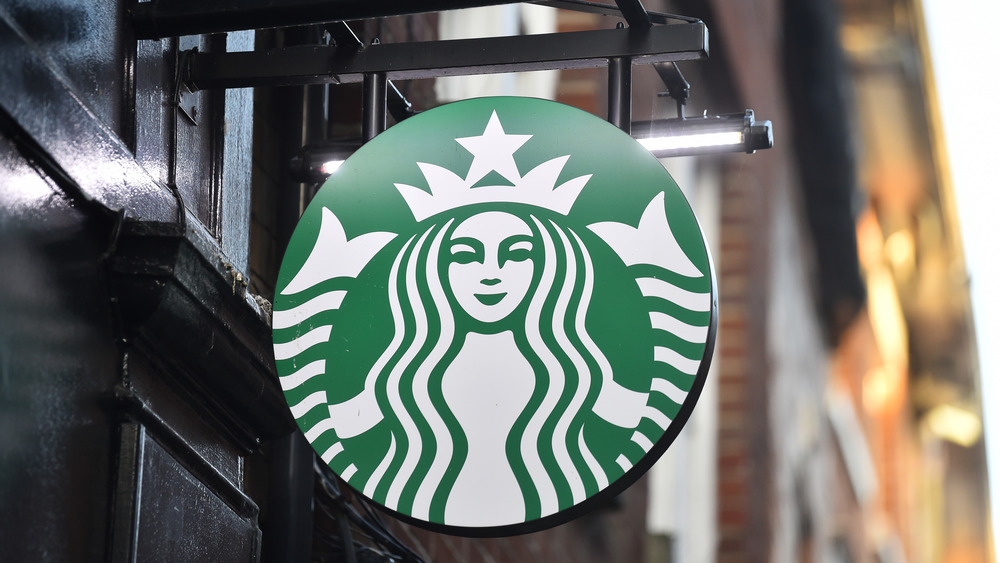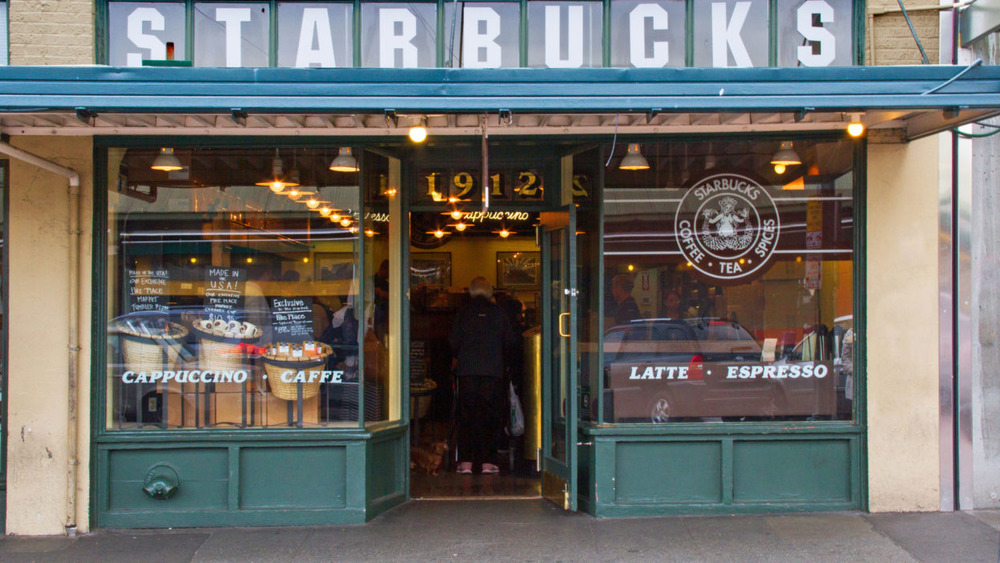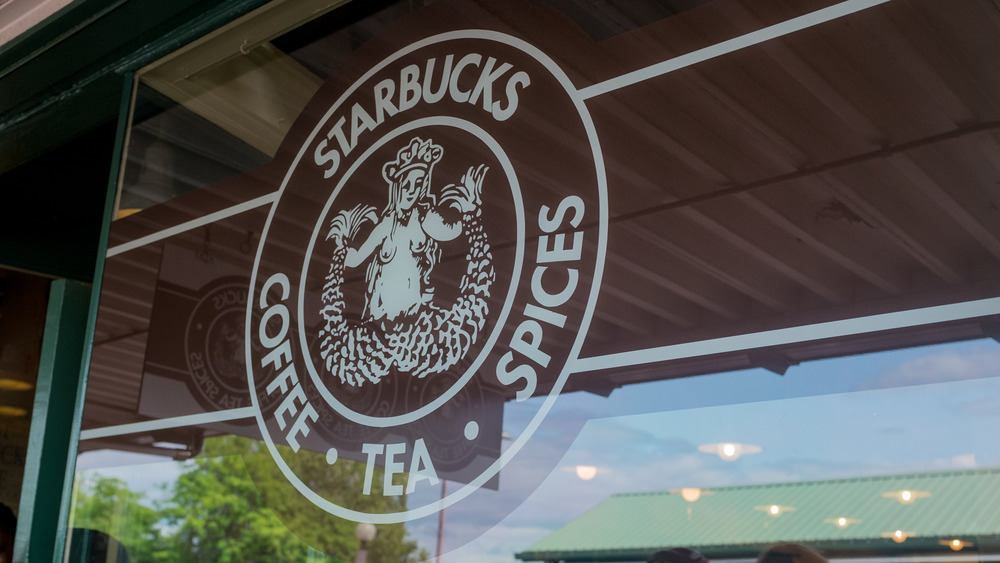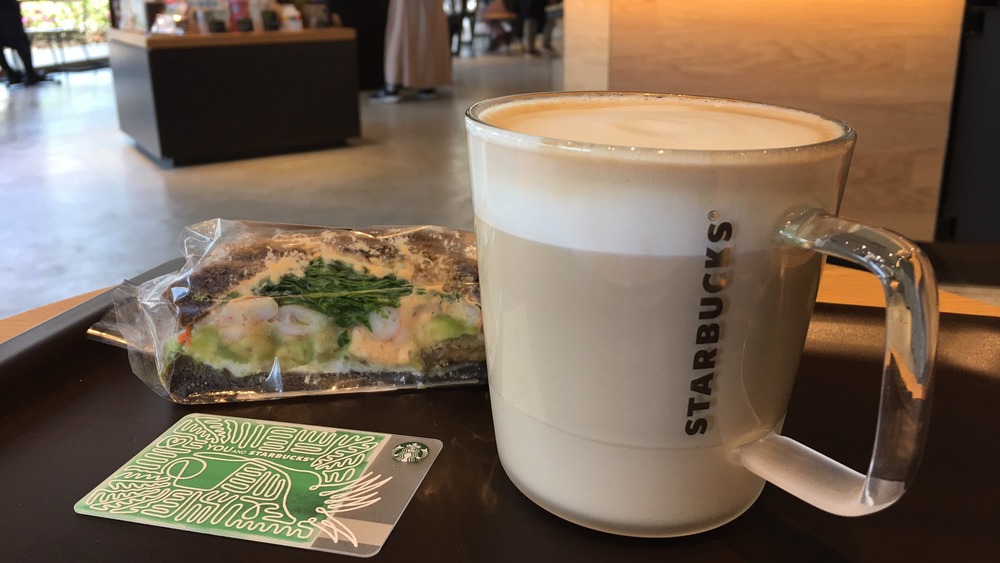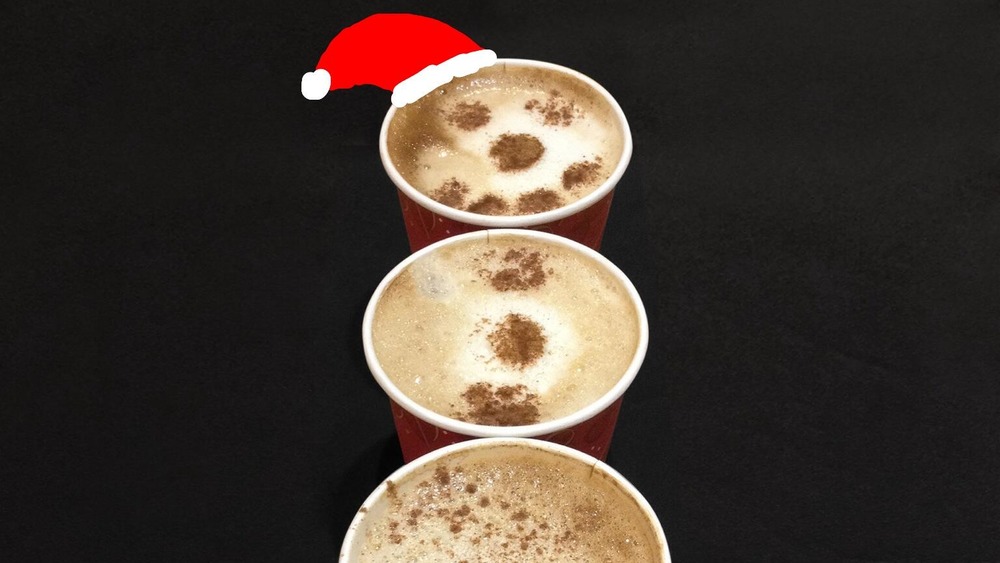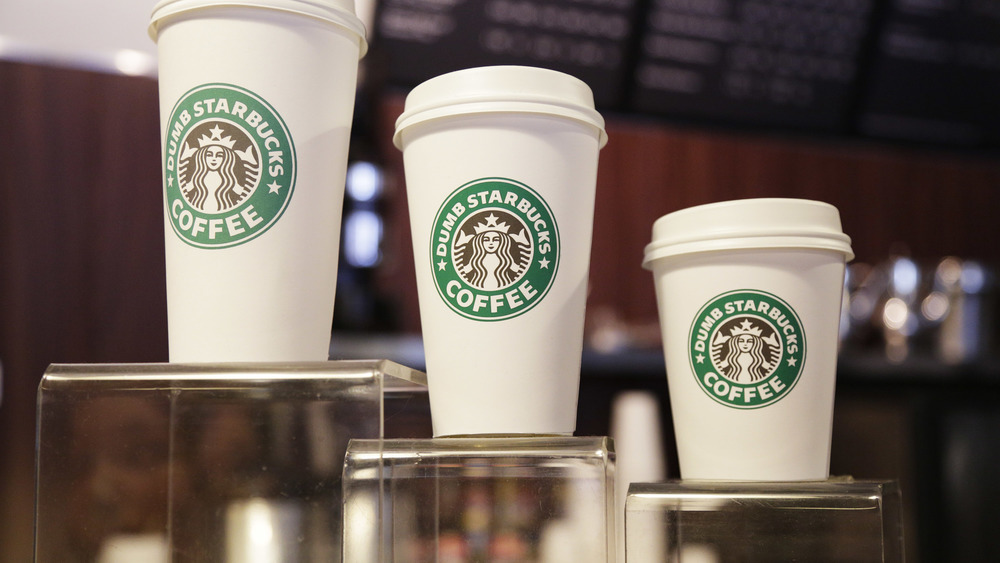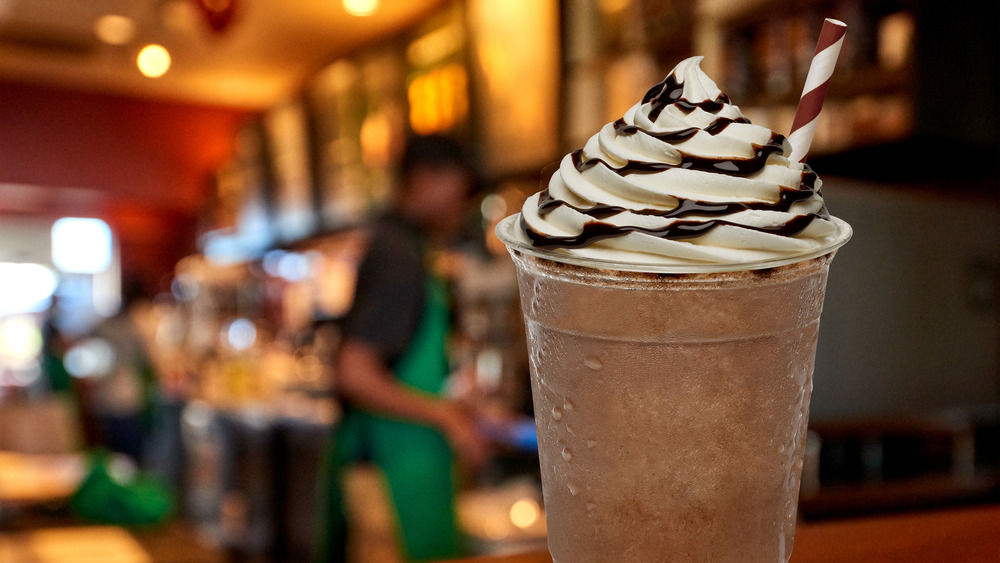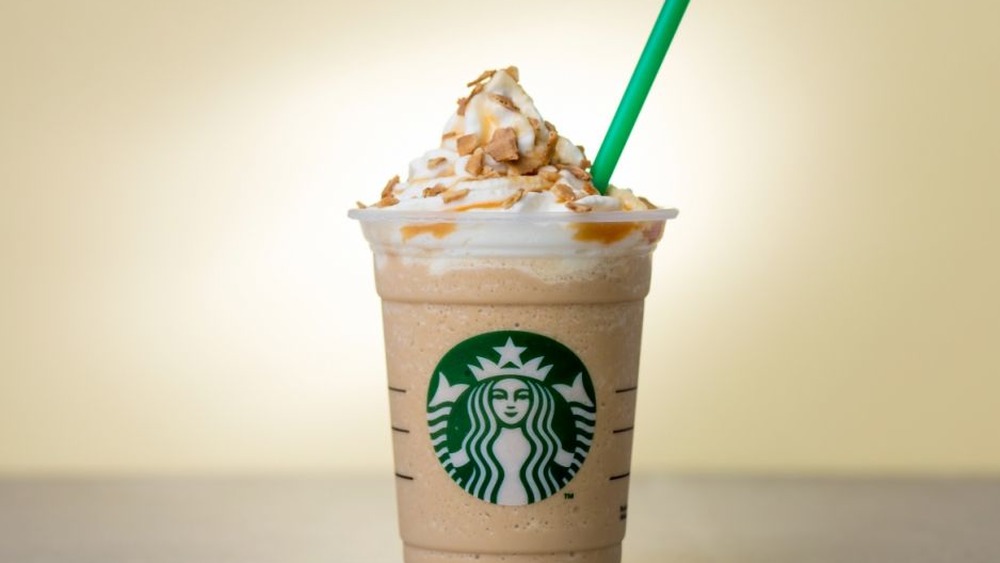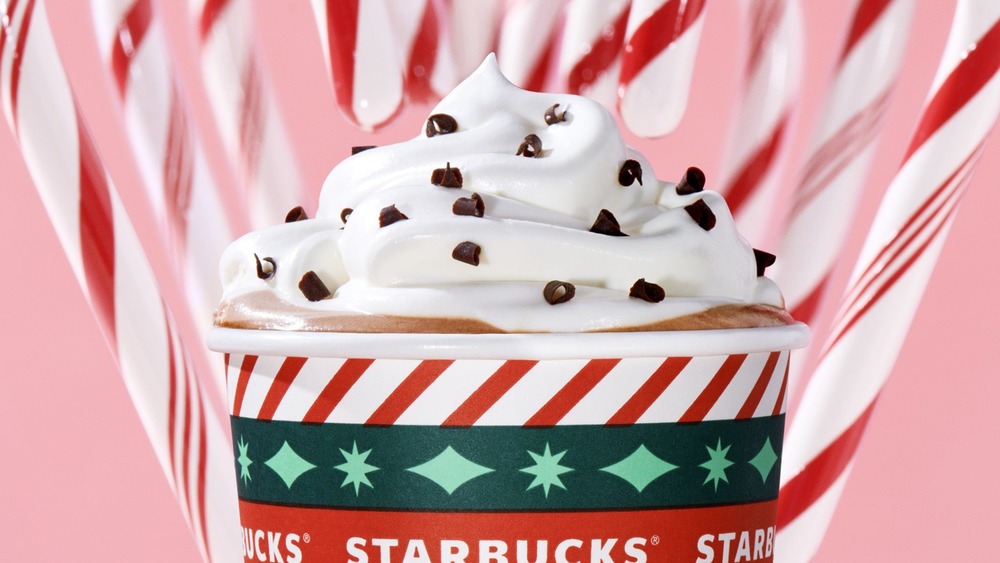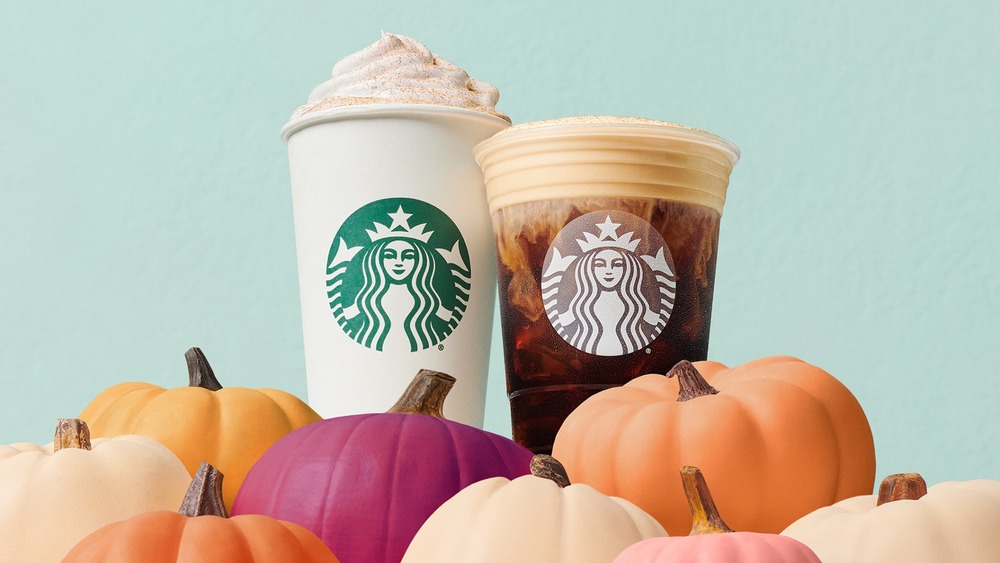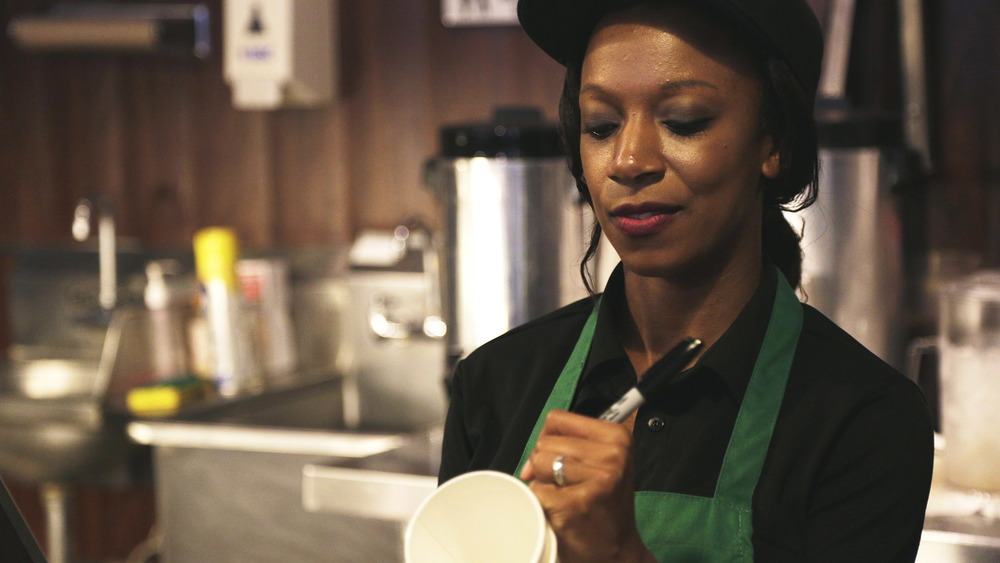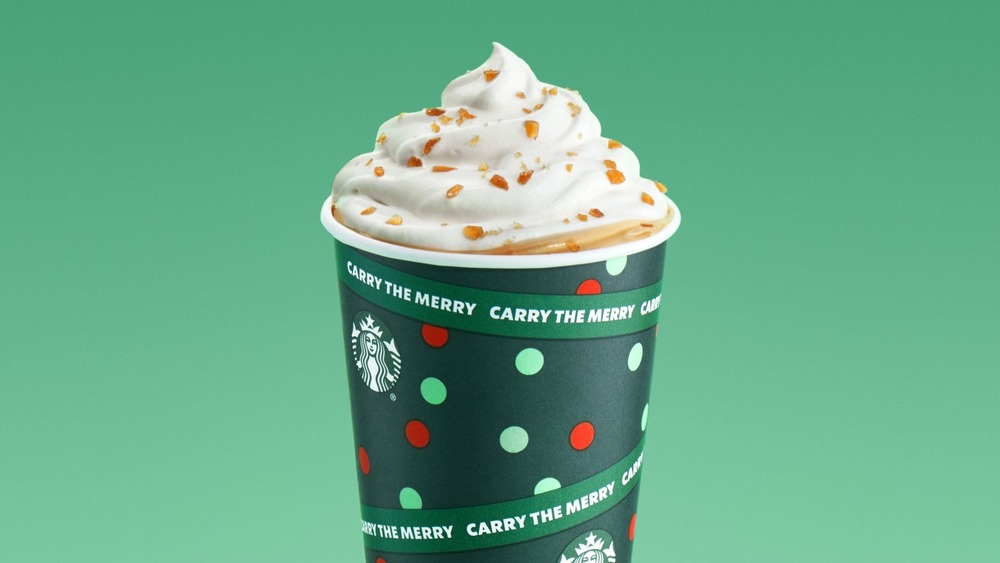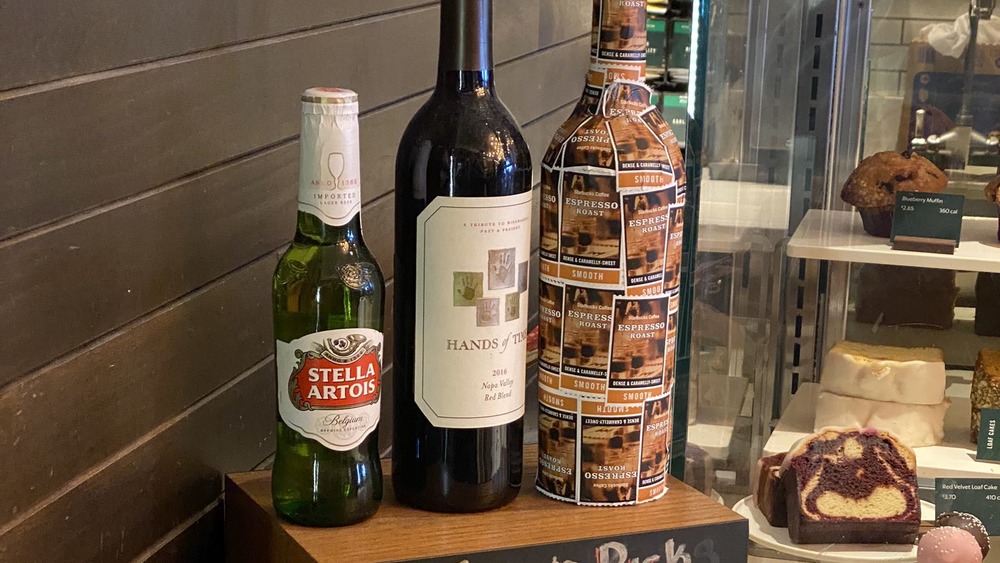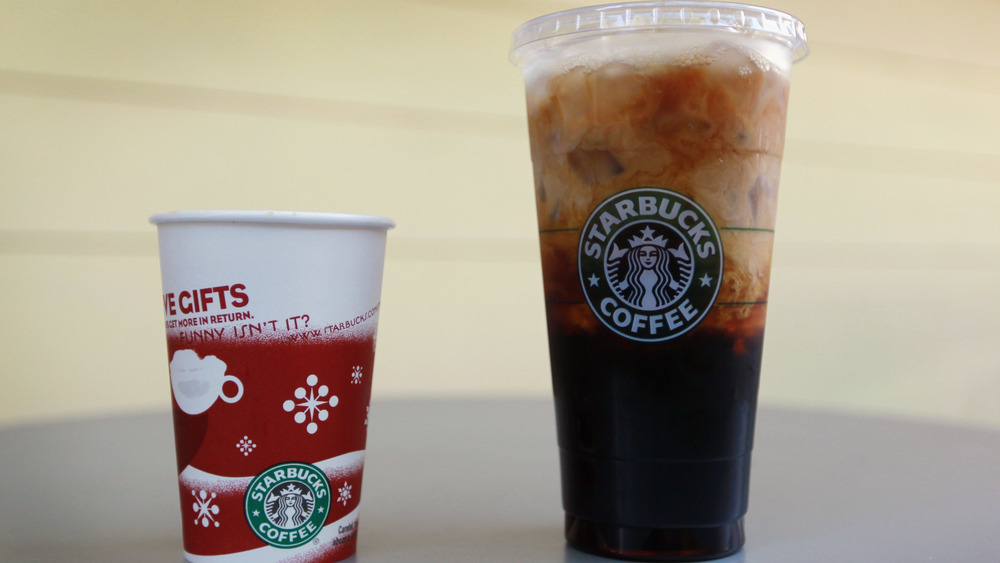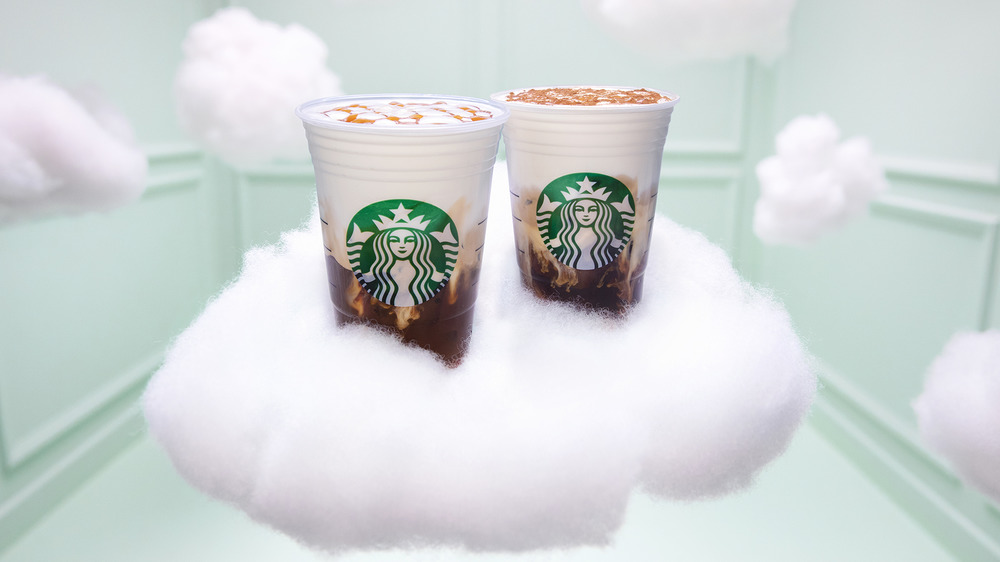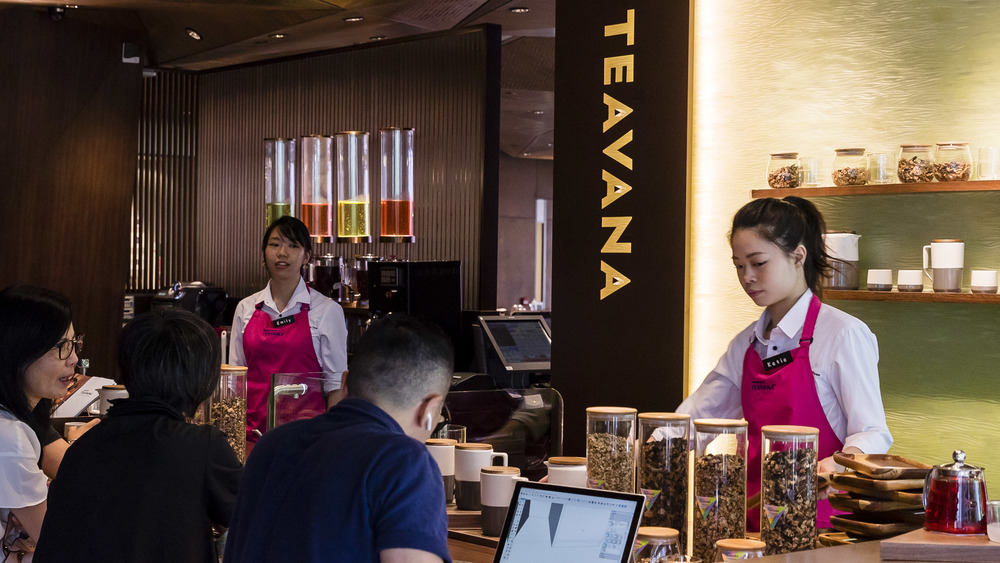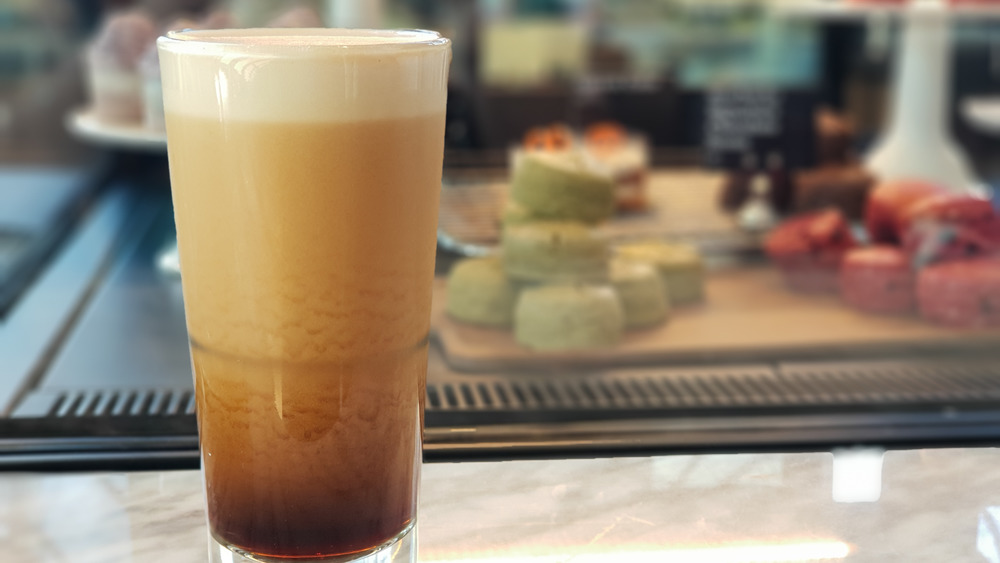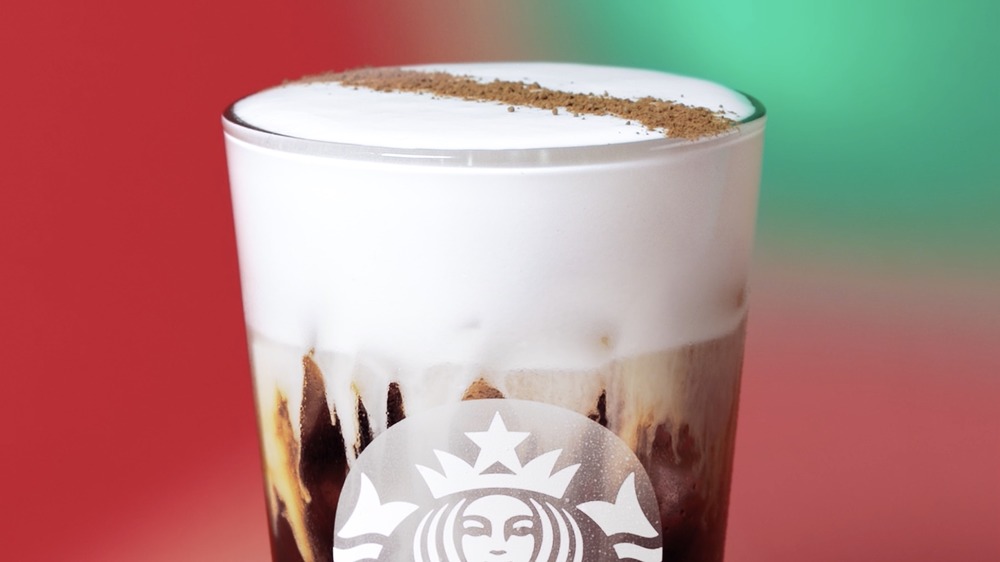What Starbucks' Menu Looked Like The Year You Were Born
For starting as a tiny coffee shop in Seattle that didn't even offer brewed coffee, Starbucks has come a long way in 50 years. Now found in 80 markets with 30,000 locations, Starbucks offers so much more than coffee, with a menu that includes baked goods, wine and beer, and sugary beverages that contain no coffee at all. Even for non-coffee drinkers, the Starbucks menu, with its "tall," "grande," and "venti" sizes, is quite recognizable, nearly as much as the brand's Greek-inspired, twin-tailed siren logo.
Starbucks' menu hasn't only influenced the coffee shop experience here in the United States, with many other brands following in its footsteps, offering an array of flavored beverages. Starbucks has essentially launched the creation of entire industries, based on some of its most popular flavors (looking at you, pumpkin spice latte).
But it's only been recently that the Starbucks menu has evolved to include such game-changing products. For the first several decades of the brand's existence, the menu was pretty straightforward.
Intrigued? Find out what Starbucks' menu looked like the year you were born.
1971 to 1981: Starbucks opens ... without a menu
If you're looking for Starbucks' menu when you were born and you were born before 1982, you're out of luck. When Starbucks first opened in Seattle in 1971, the store was a far cry from the Starbucks experience you get today. According to one article, "The store sold bulk coffee beans, tea, and spices. That — along with a selection of coffee makers, grinders, and teapots — was it. The only brewed coffee was given away as samples."
Still, it was a formula that worked for the brand — eventually. During the first nine months, the store only grossed approximately $47,000. But Starbucks went on to open multiple locations regardless and began roasting its own beans. The dedication to the brand paid off over time, and after a decade of business, Starbucks reported sales of $4.4 million over the 1980 to 1981 fiscal year, up 49 percent from the previous year. Even then, though, Starbucks didn't offer any sort of menu — the business was all focused on roasting and selling its own beans and the various coffee paraphernalia the average bean aficionado might want at home.
1982 to 1983: The most important year in Starbucks' history?
In 1982, something monumental happened for the Starbucks brand. With the fifth store opening in Seattle, this store featured something unprecedented: a coffee bar. The menu was limited, extremely so, and sold only plain, brewed coffee, but it was something. If you still enjoy a fresh, hot cup of Starbucks coffee black, ordered at the counter amidst a range of other sugar- and dairy-laden requests, you know the pure joy that comes from such a simple thing.
It was the first step Starbucks would make toward what it's become today, but there was still one missing piece of the puzzle: Howard Schultz. Schultz became the director of marketing in 1983 and was instantly a controversial, boundary-pushing figure. And when Starbucks sent Schultz to a coffee trade show in Italy, he came back full of ideas for the brand, proclaiming that espresso-based drinks and Italy's longstanding cafe culture were the way of the future (and he wasn't wrong).
1984 to 1985: A Starbucks staple is born
Fresh off his trip to Italy, Howard Schultz began to implement changes at Starbucks. The sixth Starbucks store opened in Seattle, and it included the very first Starbucks espresso bar, where, again, the menu was very limited compared to what the Starbucks menu is today. But it also included one key item that you can still order: the Starbucks Caffe Latte.
Incredibly simple, the Starbucks Caffe Latte is a hot, basic coffee drink, with dark, rich espresso, steamed milk, and a layer of foam. A tall (12-ounce) Caffe Latte includes one shot of espresso and is made with two percent milk, though today you have a whole swathe of other milk alternatives to choose from.
Possibly feeling a little emboldened by his successful changes at Starbucks, though, Schultz then left Starbucks to found his own coffee shop company where he fully embraced the Italian coffee culture (he even played opera music in the background at each of the shops!). However, his new brand, christened Il Giornale, purchased its coffee beans from Starbucks.
1986: Il Giornale creates a Starbucks holiday classic
Okay, so this was technically an Il Giornale invention, but it graces the Starbucks menu today, so it still counts. In 1986, Dave Olsen was working at the Il Giornale espresso bar, and he threw together a few ingredients to create Starbucks' very first handcrafted holiday beverage, the eggnog latte. Up until the addition of the eggnog latte to the Starbucks menu, the only holiday-esque offering that the brand had was its Christmas Blend coffee, which was only sold as beans and grounds for use at home.
The eggnog latte is made with steamed eggnog, espresso, and a dusting of nutmeg, and it has gained a following where it's sold in Starbucks locations in the United States, Canada, and Europe, where holiday revelers eagerly await its addition to the seasonal menu. The eggnog latte was the first of a long line of seasonal, holiday menu items for the brand, which continues to expand and evolve just about every year.
1987 to 1994: A new CEO at the helm brings changes to the Starbucks menu
In 1987, Starbucks' future began to look a little grim again, with cash flow not where it needed to be. The founders decided to sell and focus on their other ventures (including Red Hook Brewery and Peet's Coffee), and Howard Schultz came calling. He purchased Starbucks, with the help of investors, for $3.8 million and rebranded Il Giornale under the Starbucks name.
However, thinking back to his time in Italy and the coffee culture he had curated at his Il Giornale locations, he made a few changes to the Starbucks brand, incorporating some of Il Giornale's distinctive touches into the Starbucks menu. Most significantly, he swapped out Starbucks' small, medium, and large sizes for the tall, grande, and venti sizes that you still see today.
Schultz quickly grew the Starbucks brand, with rapid expansion in the years following the acquisition, until he had 53 locations in 1992, when the Starbucks brand went public at $17 per share. By 1993, there were nearly 300 locations across the U.S. and Canada.
1995 to 1998: A classic Starbucks beverage meets wild, immediate, and long-lasting success
Starbucks' management began to notice a trend on the coffee beverage scene: blended coffee beverages. While corporate was conducting R&D, Starbucks meanwhile purchased a Boston brand called The Coffee Connection along with a Coffee Connection product called the "frappuccino," which the brand made using a soft-serve ice cream machine.
While Starbucks didn't adopt the entire Coffee Connection recipe, it did adopt the name, rolling out the Frappuccino across all U.S. and Canadian locations in the summer of 1995. At first, the only Frappuccino flavors available were coffee and mocha, and the drink looked a bit different from what it is today (there was no whipped cream, for one), but it met instant success.
"The first week of launch we were tracking sales, and it was something like 200,000 drinks the first week — when we were hoping for 100,000," said a member of the Starbucks operations team at the time. "The next week it was 400,000 and the next it was 800,000. We had figured it would do well in Southern California — but it sold just as well in Chicago, Vancouver B.C., and Boston. It was huge."
1999 to 2001: Evolution makes way for a cult favorited flavor
The Starbucks Frappuccino craze continued throughout the late 1990s and early 2000s, but the brand also continued to make changes and improvements to the original formula. In 1999, Starbucks created the iconic green straw and domed lid for the Frappuccino, making it easier for patrons to enjoy their sugary coffee drinks complete with whipped cream. The new cup design debuted at the same time as Starbucks' addition of the Caramel Frappuccino to the menu. To this day, the Caramel Frappuccino remains one of Starbucks' best-selling Frappuccino flavors.
The beverage is made with coffee, milk, and ice, blended and then topped with whipped cream and caramel sauce. Today, you can order the Caramel Frappuccino affogato-style, which simply means that the barista adds a hot espresso shot to the top of the drink, for a unique hot-cold sensation and some extra caffeine.
Want to make your own Caramel Frappuccino at home? You'd be in luck, as this cult favorite has spawned dozens of copycat recipes online.
2002: Starbucks unleashes two huge menu items
A big year for Starbucks, in 2002, the brand continued to expand its flavored drink menu. The very first blended beverages without coffee or tea as an ingredient appeared in the summer of 2002, with the introduction of yet another Frappuccino option. The Frappuccino Creme premiered with four flavors — vanilla bean, strawberries and creme, double chocolate chip, and chai creme. According to a prior Starbucks barista, the creme line of Frappuccinos is by default made with milk, creme base, ice, and a flavoring — and a whole lot of sugar.
The new menu items didn't end in summer 2002, though. For the Christmas season, Starbucks introduced its new peppermint mocha. According to Starbucks, the beverage quickly became the most popular holiday drink in Starbucks history, and it remains the "most loved" holiday beverage on the current menu, served hot, iced, and blended, at more than 30,000 stores in 80 international markets. The only change that's been made over the years? It's now made with two percent milk and topped with dark chocolate curls rather than sprinkles.
However, even with the peppermint mocha's popularity, no one could foresee the huge menu changes that would occur in 2003.
2003: The Starbucks #PSL was a thing before hashtags were a thing
If things were going well in 2002, things were only looking up in 2003, when Starbucks debuted a menu item that would literally change the face of food culture for good: the pumpkin spice latte. A last-minute decision was made to add the pumpkin-flavored drink to the Starbucks menu, a Business of Business article notes, though there was little enthusiasm for the concept before it rolled out. The drink was initially tested in 100 stores in Vancouver and Washington, D.C., and, one Starbucks rep says, "We couldn't keep up initially ... we had to expedite inventory to the stores." Sales records were exceeded, and so the PSL went nationwide the next year. CNBC estimates that as of 2019, Starbucks has sold 424 million pumpkin spice lattes.
The OG PSL, though, was not exactly the same as the PSL you see today. In 2015, the PSL received a revamp to add squash to its recipe. Prior, the drink was made with artificial dye, nutmeg, cinnamon, and cloves.
However, that wasn't the only monumental menu change to occur in 2003. Starbucks also began testing out hot foods, with its breakfast sandwiches, which are still around today. The first available hot sandwiches were a toasty egg and cheese, to be followed in 2006 by a bacon and ham sandwich and English muffin sandwiches.
2004 to 2008: Starbucks goes skinny
By 2004, the Frappuccino had been successfully around for more than a decade, but Starbucks decided to take things further and attempt to make the drink appealing for a wider audience with the introduction of the Frappuccino Light. The blended beverage came in the original Frappuccino flavors but with 30 to 40 percent fewer calories.
That wasn't the only way that Starbucks would decide to make its drinks more waistline-friendly, though, through the mid- and late-2000s. In 2008, Starbucks introduced its "skinny" drinks. By ordering drinks "skinny," customers essentially asked baristas to use sugar-free flavored syrups in their drinks of choice versus the full-sugar variants. The addition of the skinny option also included the introduction of a new syrup flavor to the lineup of vanilla, hazelnut, caramel, and cinnamon dolce: mocha. A tall, skinny caffe mocha or caffe latte came out to only 90 calories. "If customers replace their daily tall Starbucks Vanilla Latte with Starbucks Skinny Vanilla Latte they would save 700 calories and 35 grams of fat per week," reported Starbucks.
2009: Starbucks introduces another holiday hit with the caramel brulee latte
In 2009, Starbucks introduced a new seasonal drink, the caramel brulee latte, which became an instant hit and fan favorite to the point that you can find copycat recipes and Starbucks "secret menu hacks" online for those who need their caramel brulee latte fix year-round. Mashed even crowned the drink its second-best Starbucks holiday beverage in 2019. Buttery, creamy, super sweet, and decadent, the latte is made with a shot of espresso, steamed milk, and caramel brulee sauce, then topped with whipped cream and some caramel brulee bits.
The drink has come and gone from the seasonal menu since being introduced in 2009, with pretty reliable regularity the last several years, as Starbucks realizes it has another hit on its hands (the brand even went so far as to sell a caramel brulee latte kit for a while, which includes Starbucks' Christmas Blend Espresso Roast coffee and a caramel brulee sauce).
2010: Starbucks just wants you to have it your way — and to let you relax a little
Another year with multiple changes to the Starbucks menu, 2010 introduced the world to the first However-You-Want-It Frappuccino. The menu addition allows customers to choose their own milk option (like soy), their own type of coffee, whatever syrup they want, and an array of toppings. Starbucks announced that this menu change allowed for thousands of new Frappuccinos to be made, ordered however customers liked.
A more dramatic change came to the menu in 2010, though: Beer and wine were added to select locations' menus. According to an LA Times article, a Starbucks spokesperson said that the menu change was adopted for customers "who want to relax in the evening," noting "The feedback and reaction from our customers has been really positive. We don't break out store-level specifics for financial reasons, but the feedback has been positive."
Still, this menu change couldn't have been that successful — as you still can't find beer and wine on Starbucks menus nationwide.
2011 to 2013: Starbucks decides to go bigger than ever
Is bigger really better? In 2011, Starbucks certainly thought so, as it unleashed its trenta option into the world. The largest of Starbucks' available drink sizes, a trenta drink gives customers 31 ounces of their favorite beverage. Unfortunately, when the new size was added to the menu, you couldn't order 31 ounces of your favorite hot coffee to go. Instead, the size was available for iced coffee, iced tea, and iced tea lemonade only. Previously, Starbucks' largest size was the venti, at 20 ounces. Despite the additional ten ounces of beverage, though, Starbucks only increased the price of its drinks from venti to trenta by about $0.50, at least upon release.
One helpful graphic released by the National Post pointed out that the 916-milliliter venti cup exceeded the average capacity of the adult human stomach by about 16 milliliters and takes up about a quarter of the maximum capacity of the adult human stomach.
2014: Starbucks introduces cold foam and chestnut lattes
In 2014, Starbucks made two notable changes to its menu. Around the holidays, it introduced yet another new holiday drink, the chestnut praline latte, though it doesn't quite achieve the same following as some of the other Starbucks holiday drinks that have withstood the test of time. Many patrons, though, acknowledged that the latte was a nice change from the considerably sweeter other holiday drink options. Made with espresso, steamed milk, foam, whipped cream, and spiced praline crumbs, an R&D manager for Starbucks at the time said she was inspired by her experiences working in European restaurants and hotels and by European Christmas markets in creating the new flavor.
Cold foam also became available as an addition to cold beverages in 2014, though not in all Starbucks locations (it would become more widely available in 2018). A Food Business News article noted, "The frothy topping falls in line with the trend of cold beverages, which now make up more than half of U.S. Starbucks beverage sales."
2015: Coconut milk, hot tea, cold coffee, and more
In 2015, Starbucks boasted a few menu changes that were more coffee-adjacent. Coconut milk became an option for non-dairy drinkers for an extra $0.60 per drink. Starbucks went with its own branded coconut milk, Starbucks Single Origin Sumatra Coconut Milk, which is vegan and made from single-origin coconuts from — you guessed it — Sumatra. A USA Today article said that non-soy, non-dairy alternatives were the second-most-requested customer ideas submitted to Starbucks at the time.
Starbucks also began selling hot brewed teas in-store in 2015. The new Teavana hot teas included ten varieties, such as jade citrus mint, Emperor's Clouds & Mist, Oprah Chai, Youthberry, and English breakfast. Prepared with just hot water and tea sachets, there's still nothing necessarily exciting or groundbreaking about Starbucks' tea selections, but the menu addition makes sense for the clientele, and the tea options have continued to increase and evolve over the years.
However, one of the biggest menu additions was that of cold brew. Steeped using cold water, Starbucks explained the difference between its iced coffee, which "has a stronger, roastier flavor with a bit of nuttiness that comes from brewing with hot water," and its new cold brew, which it described as "smooth and rich ... it's very refreshing with chocolate and light citrus notes." Cold brew first launched in nearly 3,000 locations across the United States and Canada.
2016: Starbucks goes colder with nitro coffee
Starbucks' cold brew was quickly followed by nitro coffee, or cold brew coffee infused with nitrogen gas, before the end of 2016, though the roll-out was a little more contained compared to the initial roll out of cold brew, with only around 500 Starbucks locations offering nitro coffee initially. Starbucks was the third and the largest chain to serve nitro coffee at the time, following Stumptown Coffee Roasters and Caribou Coffee.
"Nitro coffee has been under development at Starbucks for about a year," Mackenize Karr, a coffee education specialist with Starbucks, told CNBC at the time, "and cold brew was a natural choice given the blend of beans and quality of roast."
At the same time that Starbucks launched nitro coffee, it also unveiled a new cold brew coffee drink, the vanilla sweet cream cold brew, served on ice and topped with a cream concoction made from milk, cream, and vanilla syrup.
2017 to 2019: Starbucks continues to expand seasonal, holiday options
If there's one thing you can rely on Starbucks to do, it's to roll out new holiday and seasonal drink options every few years like clockwork. In 2017, Starbucks introduced its toasted white chocolate mocha, and in 2019, it unleashed its Irish cream cold brew (there was a break in 2018).
The former combines the flavors of toasted white chocolate, espresso, whipped cream, and candied cranberry sugar, and the drink received rave reviews upon its release. The latter, meanwhile, combines cold brew coffee with Irish cream syrup, ice, vanilla sweet cream cold foam, and cocoa powder. (In Canada, a hot version was available, called the Irish Cream Americano.)
Additionally, 2019 also introduced Starbuck patrons to the new pumpkin cream cold brew, which was the first new pumpkin beverage to land on the menu since the pumpkin spice latte launched in 2003. Made with cold brew and vanilla, the pumpkin cream cold brew is topped with a pumpkin cream cold foam and pumpkin spice topping.
